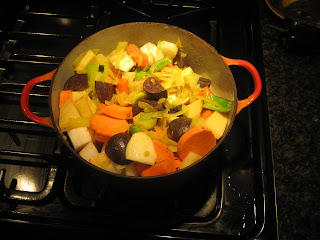Here is a gift for winter vegetables and hearty eating. Locro, as it's called, comes from South America and is essentially a vegetable stew that takes many forms. In Ecuador and Argentina it's made with potatoes and cheese. In Bolivia and Peru, it features local squash. No matter what's in the pot, locro celebrates indigenous plants. For us it's a reminder of how much we owe South American natives for what we get to grow and eat: squash, potatoes, corn, peppers, tomatoes, beans. Imagine life, or your local farmers' market, without them. And celebrate with this simple, tasty dish.
This is a Peruvian locro to which I've added a few spices that compensate for the unavailability of the local yellow chili pepper, aji amarillo.
For vegetarians, this with an avocado salad and perhaps some pickled onions makes a meal.
For carnivores, it can be served in smaller quantity beside roasted or grilled meat, particularly beef.
Happy New Year and Happy Eating. Coming soon: Bean me up, Scotty! Great winter eating Italian style.
Peruvian Squash and Potato Stew, Locro de Zapallo
For 6-8
2 lbs winter squash like butternut, red kuri, sugar pumpkin,
1 lb. Yukon gold potatoes, scrubbed
3 tbsp corn oil
1 tbsp unsalted butter
1 lg red onion, diced
3 lg garlic cloves, minced
1 poblano pepper, roasted and diced
1 Serrano or other hot chili, minced
1 tsp ground cumin
1 tsp dried oregano leaves
¼ tsp smoked paprika
½ tsp ground Chipotle chili
2 cups vegetable or chicken broth
1 cup raw corn kernels, larger are better
salt to your taste
¼ tsp fresh black pepper
½ cup large peas, fresh or frozen
½ cup evaporated milk unsweetened, (this can be optional)
½ lb queso fresco or feta, cubed
½ cup cilantro leaves, chopped for garnish
¼ cup toasted pumpkin seeds, optional garnish
Peel the squash and cut into 1” cubes. Cube the potatoes.
Heat the oil and butter in a heavy gauge casserole or soup
pot.
Add onion, garlic, and poblano pepper. Sauté on medium heat
until onion is soft.
Add chili pepper, and spices. Blend well.
Add potatoes, squash and corn to the pot and stir to cover
them with the spice/onion mix.
Add the vegetable broth. Bring to a boil, then cover and
reduce heat to simmer. Cook until squash and potatoes are tender but not mushy,
about 20-30 minutes.
Add salt, pepper and peas. Simmer 2 minutes to heat peas.
Remove cover.
Add evaporated milk and cheese. Simmer just long enough to
heat. Do not boil.
Serve over quinoa and sprinkle on cilantro. Top with pumpkin
seeds.









